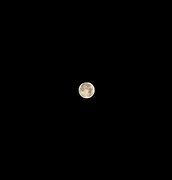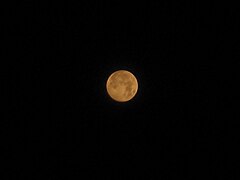June 2020 lunar eclipse
Appearance
| Penumbral Lunar Eclipse 5 June 2020 | |
|---|---|
 View from Johannesburg, South Africa 19:18 UTC | |
 The moon passes west to east through the earth's southern penumbral shadow. | |
| Series (and member) | 111 (67 of 71) |
| Duration (hr:mn:sc) | |
| Penumbral | 3:18:13 |
| Contacts | |
| P1 | 17:45:50 UTC |
| Greatest | 19:25:02 |
| P4 | 21:04:03 |
A penumbral lunar eclipse took place on 5 June 2020. It was the second of four penumbral lunar eclipses in 2020.[1]
Visibility
It was visible in most parts of Europe (except northern Scandinavia), Asia (except North-East of Russian Far East), Africa, Australia, eastern parts of South America and Antarctica.

|
 Visibility map |
Gallery
-
San Jose del Monte, Philippines, 18:51 UTC
-
Hefei, China, 19:25 UTC
-
Nakhodka, Russia, 19:26 UTC
-
Moscow, Russia, 19:33 UTC
-
Blora Regency, Indonesia, 19:39 UTC
-
Logroño, Spain, 19:56 UTC
-
Surabaya, Indonesia, 19:25 UTC
Related eclipses
Eclipses of 2020
- A penumbral lunar eclipse on January 10.
- A penumbral lunar eclipse on June 5.
- An annular solar eclipse on June 21.
- A penumbral lunar eclipse on July 5.
- A penumbral lunar eclipse on November 30.
- A total solar eclipse on December 14.
Lunar year series
| Lunar eclipse series sets from 2020–2023 | ||||||||
|---|---|---|---|---|---|---|---|---|
| Descending node | Ascending node | |||||||
| Saros | Date | Type Viewing |
Gamma | Saros | Date Viewing |
Type Chart |
Gamma | |
111
|
2020 Jun 05
|
Penumbral
|
1.24063 | 116
|
2020 Nov 30
|
Penumbral
|
−1.13094 | |
121
|
2021 May 26
|
Total
|
0.47741 | 126
|
2021 Nov 19
|
Partial
|
−0.45525 | |
131
|
2022 May 16
|
Total
|
−0.25324 | 136
|
2022 Nov 08
|
Total
|
0.25703 | |
141
|
2023 May 05
|
Penumbral
|
−1.03495 | 146
|
2023 Oct 28
|
Partial
|
0.94716 | |
| Last set | 2020 Jul 05 | Last set | 2020 Jan 10 | |||||
| Next set | 2024 Mar 25 | Next set | 2024 Sep 18 | |||||
Saros series
It is part of Saros cycle 111.
Half-Saros cycle
A lunar eclipse will be preceded and followed by solar eclipses by 9 years and 5.5 days (a half saros).[2] This lunar eclipse is related to two partial solar eclipses of Solar Saros 118.
| June 1, 2011 | June 12, 2029 |
|---|---|

|

|
See also
References
- ^ 2020 Jun 05 chart: Eclipse Predictions by Fred Espenak, NASA/GSFC
- ^ Mathematical Astronomy Morsels, Jean Meeus, p.110, Chapter 18, The half-saros









